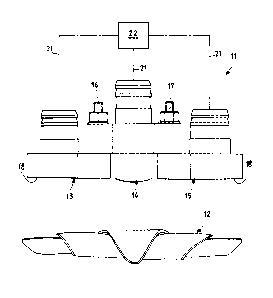Some of the information on this Web page has been provided by external sources. The Government of Canada is not responsible for the accuracy, reliability or currency of the information supplied by external sources. Users wishing to rely upon this information should consult directly with the source of the information. Content provided by external sources is not subject to official languages, privacy and accessibility requirements.
Any discrepancies in the text and image of the Claims and Abstract are due to differing posting times. Text of the Claims and Abstract are posted:
| (12) Patent Application: | (11) CA 2392535 |
|---|---|
| (54) English Title: | DEVICE FOR THE FORMATION OF CROISSANTS MADE OF PUFF PASTRY OR THE LIKE |
| (54) French Title: | DISPOSITIF POUR FORMER DES CROISSANTS FAITS DE PATE FEUILLETEE OU D'UNE PATE SEMBLABLE |
| Status: | Deemed Abandoned and Beyond the Period of Reinstatement - Pending Response to Notice of Disregarded Communication |
| (51) International Patent Classification (IPC): |
|
|---|---|
| (72) Inventors : |
|
| (73) Owners : |
|
| (71) Applicants : |
|
| (74) Agent: | NORTON ROSE FULBRIGHT CANADA LLP/S.E.N.C.R.L., S.R.L. |
| (74) Associate agent: | |
| (45) Issued: | |
| (22) Filed Date: | 2002-07-05 |
| (41) Open to Public Inspection: | 2003-01-06 |
| Examination requested: | 2007-04-04 |
| Availability of licence: | N/A |
| Dedicated to the Public: | N/A |
| (25) Language of filing: | English |
| Patent Cooperation Treaty (PCT): | No |
|---|
| (30) Application Priority Data: | ||||||
|---|---|---|---|---|---|---|
|
A device for the formation of croissants made of puff
pastry or the like, said croissants being initially
shaped into pastry rolls (12) starting from flat puff
pastry, wherein there are at least two gripping or
clasping and folding elements (13, 14, 15), connected by
an articulated joint (16, 17) and suitable for being
transferred, aligned with each other, onto portions of a
puff pastry roll (12), withholding the roll (12) and
being moved to a folded position thus causing the firmly
held pastry roll to take on the form of a U- or crescent
shape, there also being driving systems (25, 26) for the
reciprocal movement between the at least two gripping or
clasping and folding elements (13, 14, 15). The invention
also relates to a process for the formation of croissants
made of puff pastry or the like, wherein each croissant,
in the form of a cylindrical pastry roll, is gripped by
at least two jointed gripping and folding elements (13,
14, 15), maintained in a firm position and folded to form
a U- or crescent shape by moving the two gripping or
clasping and folding elements, before being released in a
folded position.
11
Note: Claims are shown in the official language in which they were submitted.
Note: Descriptions are shown in the official language in which they were submitted.

2024-08-01:As part of the Next Generation Patents (NGP) transition, the Canadian Patents Database (CPD) now contains a more detailed Event History, which replicates the Event Log of our new back-office solution.
Please note that "Inactive:" events refers to events no longer in use in our new back-office solution.
For a clearer understanding of the status of the application/patent presented on this page, the site Disclaimer , as well as the definitions for Patent , Event History , Maintenance Fee and Payment History should be consulted.
| Description | Date |
|---|---|
| Application Not Reinstated by Deadline | 2010-04-07 |
| Inactive: Dead - No reply to s.30(2) Rules requisition | 2010-04-07 |
| Deemed Abandoned - Failure to Respond to Maintenance Fee Notice | 2009-07-06 |
| Inactive: Abandoned - No reply to s.30(2) Rules requisition | 2009-04-07 |
| Inactive: S.30(2) Rules - Examiner requisition | 2008-10-07 |
| Letter Sent | 2007-04-26 |
| Request for Examination Received | 2007-04-04 |
| Request for Examination Requirements Determined Compliant | 2007-04-04 |
| All Requirements for Examination Determined Compliant | 2007-04-04 |
| Inactive: IPC from MCD | 2006-03-12 |
| Application Published (Open to Public Inspection) | 2003-01-06 |
| Inactive: Cover page published | 2003-01-05 |
| Letter Sent | 2002-12-09 |
| Inactive: Single transfer | 2002-10-24 |
| Inactive: IPC assigned | 2002-09-05 |
| Inactive: First IPC assigned | 2002-09-05 |
| Inactive: IPC assigned | 2002-09-05 |
| Inactive: Courtesy letter - Evidence | 2002-08-27 |
| Inactive: Filing certificate - No RFE (English) | 2002-08-21 |
| Filing Requirements Determined Compliant | 2002-08-21 |
| Application Received - Regular National | 2002-08-21 |
| Abandonment Date | Reason | Reinstatement Date |
|---|---|---|
| 2009-07-06 |
The last payment was received on 2008-07-03
Note : If the full payment has not been received on or before the date indicated, a further fee may be required which may be one of the following
Please refer to the CIPO Patent Fees web page to see all current fee amounts.
| Fee Type | Anniversary Year | Due Date | Paid Date |
|---|---|---|---|
| Application fee - standard | 2002-07-05 | ||
| Registration of a document | 2002-10-24 | ||
| MF (application, 2nd anniv.) - standard | 02 | 2004-07-05 | 2004-06-23 |
| MF (application, 3rd anniv.) - standard | 03 | 2005-07-05 | 2005-06-16 |
| MF (application, 4th anniv.) - standard | 04 | 2006-07-05 | 2006-06-27 |
| Request for examination - standard | 2007-04-04 | ||
| MF (application, 5th anniv.) - standard | 05 | 2007-07-05 | 2007-06-14 |
| MF (application, 6th anniv.) - standard | 06 | 2008-07-07 | 2008-07-03 |
Note: Records showing the ownership history in alphabetical order.
| Current Owners on Record |
|---|
| VORTEX SYSTEMS S.R.L. |
| Past Owners on Record |
|---|
| ARTURO COLAMUSSI |